Abstract
BACKGROUND: Autologous T cells genetically modified to express a chimeric antigen receptor consisting of an external anti-CD19 single chain antibody domain with CD3ζ and 4-1BB signaling domains (CTL019 cells) can mediate potent anti-tumor effects in patients (pts) with relapsed or refractory chronic lymphocytic and acute lymphoblastic leukemias. We are conducting a phase IIa clinical trial to evaluate the safety and efficacy of CTL019 cells in pts with relapsed or refractory CD19+ non-Hodgkin lymphomas (NHL).
METHODS: Pts with CD19+ diffuse large B cell lymphoma (DLBCL), follicular lymphoma (FL), or mantle cell lymphoma (MCL) with no available curative treatment options, a limited prognosis (<2 years anticipated survival), and responsive or stable disease with most recent therapy are eligible. Pts with DLBCL have residual disease after primary and salvage therapies and are not eligible for autologous stem cell transplant (ASCT) or have relapsed or residual disease after ASCT; FL pts have progression of lymphoma <2 years after second or higher line of therapy (not including single agent monoclonal antibody therapy); MCL pts have relapsed, residual, or progressive disease after rituximab-chemotherapy combination therapy and are not appropriate for transplant or have relapsed after transplant. After steady state apheresis to collect peripheral blood leukocytes, pts receive lymphodepleting chemotherapy based on disease burden, histology, and past therapies. One to 4 days after chemotherapy, pts receive a single dose of CTL019 cells by intravenous infusion. Peripheral blood and marrow samples are collected for immunophenotypic, cytokine, and molecular studies at pre-specified times after T cell infusion. Initial tumor response assessment is performed 3 months after T cell infusion using International Working Group response criteria. Enrollment started in February 2014; data reported here are through July 26, 2015.
RESULTS: To date, 38 pts have enrolled (DLBCL 21; FL 14; MCL 3). The median age is 56 years (range: 25-77), male: female ratio is 22:16, median number of prior therapies is 4 (range: 1-10), and number of pts with prior transplant is 12 (32%; 11 ASCT, 1 allotransplant). Ann Arbor stages at enrollment are: Stage IV 23 pts (61%), Stage III 7 pts (18%), Stage II 6 pts (16%), Stage 1E 2 pts (5%); 11 pts (29%) had bone marrow involvement. LDH was increased in 28 pts (74%). ECOG PS was 0 in 16 pts (42%) and 1 in 22 pts (58%). As of July 26, 2015, 24 patients have received the protocol-specified dose of CTL019 cells (13 DLBCL; 9 FL; 2 MCL). Lymphodepleting chemotherapy regimens were bendamustine (6 pts), cyclophosphamide (11 pts), cyclophosphamide-fludarabine (1 pt), modified EPOCH (3 pts), and radiation-cyclophosphamide (3 pts). Median total CTL019 cell dose is 5.00e8 (range: 1.79e8 - 5.00e8); median CTL019 cell dose/kg is 5.84e6 (range: 3.08e6-8.87e6). Median peak CTL019 cell expansion in blood occurred 7 days after infusion (range: 2-14 days); there was no difference in peak expansion between responders and non-responders. Cytokine release syndrome (CRS) occurred in 16 pts (14 grade 2; 1 grade 3; 1 grade 4) and did not predict response. Neurologic toxicity occurred in 3 pts: 2 episodes of delirium (1 grade 2, 1 grade 3) and one possibly related grade 5 encephalitis. 22 pts are evaluable for response (DLBCL 13, FL 7, MCL 2). Overall response rate (ORR) at 3 months is 68% (15/22): DLBCL 54% (7/13); FL 100% (7/7); MCL 50% (1/2). At the median follow-up 11.7 months, progression-free survival (PFS) from CTL019 infusion is 62% (DLBCL 43%; FL 100%). For responders at median follow up, response duration is 83% for DLBCL and 100% for FL.
CONCLUSIONS: These results demonstrate that CTL019 cells can be prepared from extensively pretreated pts with active NHL and can induce durable responses with toxicity that is less than reported for chronic lymphocytic and acute lymphoblastic leukemias.
Schuster:Phamacyclics: Consultancy, Research Funding; Novartis: Research Funding; Gilead: Research Funding; Janssen: Research Funding; Nordic Nanovector: Membership on an entity's Board of Directors or advisory committees; Celgene: Consultancy, Research Funding; Genentech: Consultancy; Hoffman-LaRoche: Research Funding. Svoboda:Seattle Genetics: Research Funding; Celgene: Research Funding; Celldex: Research Funding; Immunomedics: Research Funding. Dwivedy Nasta:BMS: Research Funding; Millenium Takeda: Research Funding. Porter:Genentech: Other: Spouse Employment; Novartis: Patents & Royalties, Research Funding. Mato:Celgene Corportation: Consultancy, Research Funding; Genentech: Consultancy; Pharmacylics: Consultancy, Research Funding; Pronai Pharmaceuticals: Research Funding; AbbVie: Consultancy, Research Funding; Janssen: Consultancy; TG Therapeutics: Research Funding; Gilead: Consultancy, Research Funding. Lacey:Novartis: Research Funding. Melenhorst:Novartis: Research Funding. Chew:Novartis: Patents & Royalties. Hasskarl:Novartis: Employment, Equity Ownership. Shah:Novartis: Employment, Equity Ownership. Wasik:Janseen and Novartis: Research Funding. Zheng:Novartis: Patents & Royalties. Levine:Novartis: Patents & Royalties, Research Funding. June:Novartis: Patents & Royalties, Research Funding.
Author notes
Asterisk with author names denotes non-ASH members.


